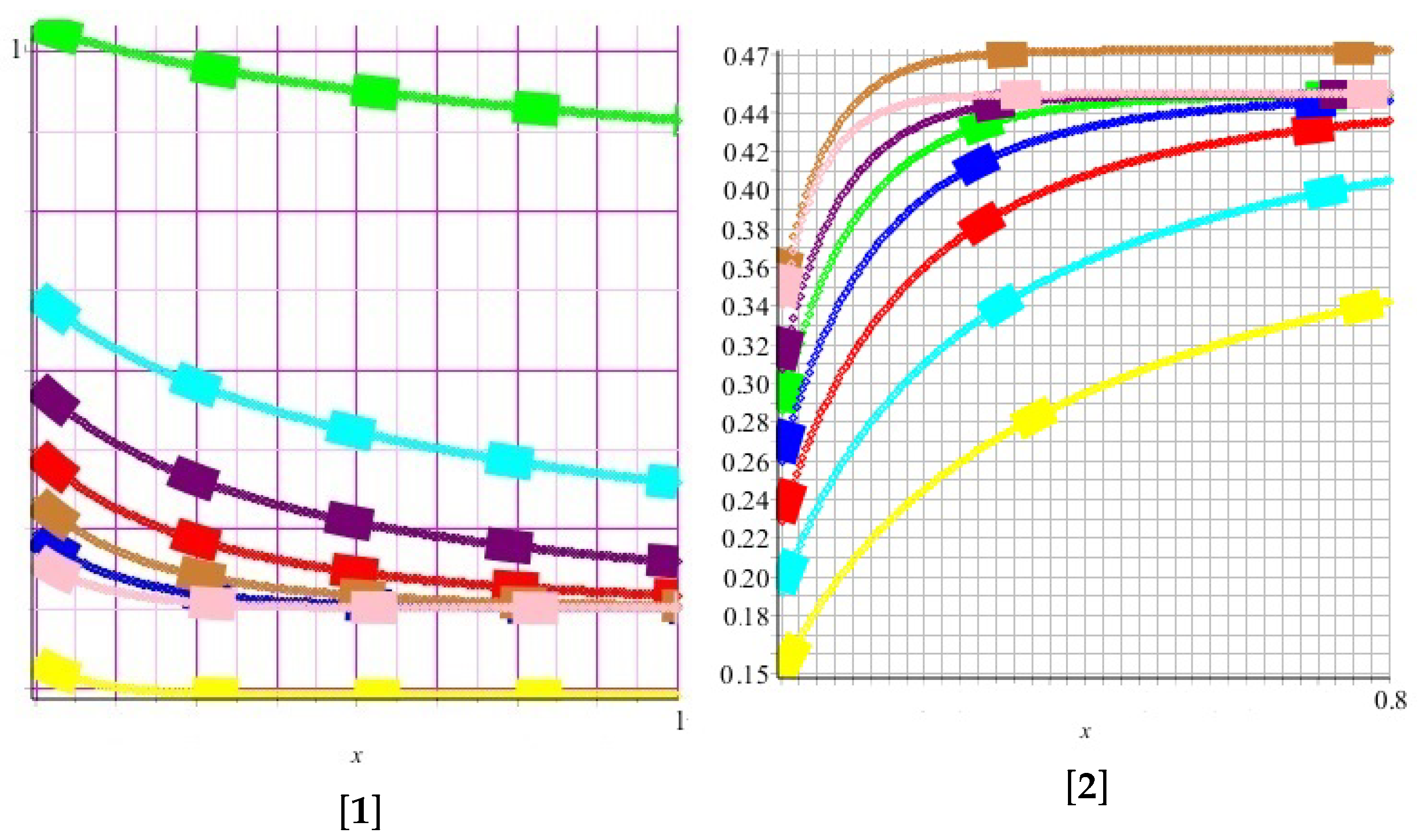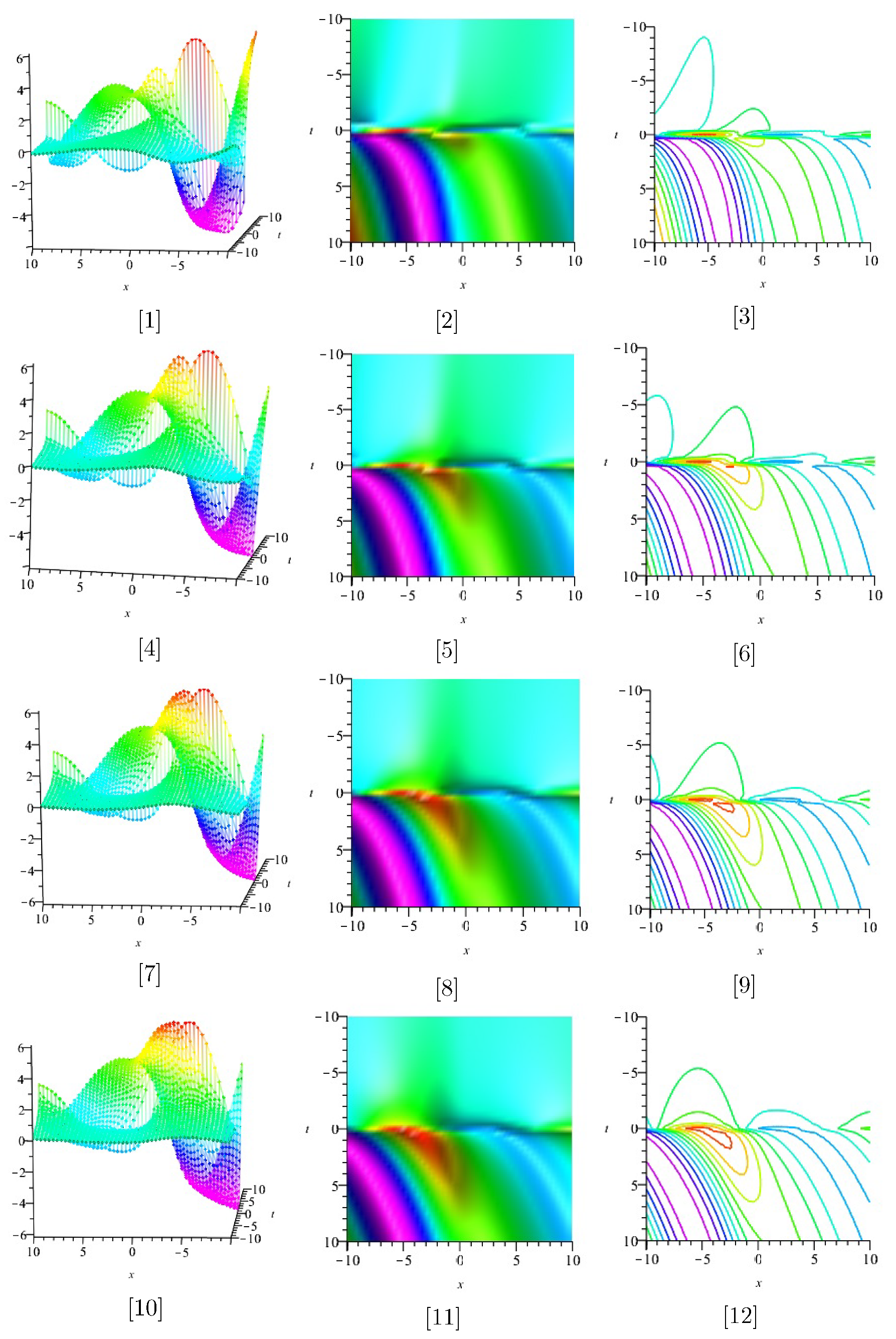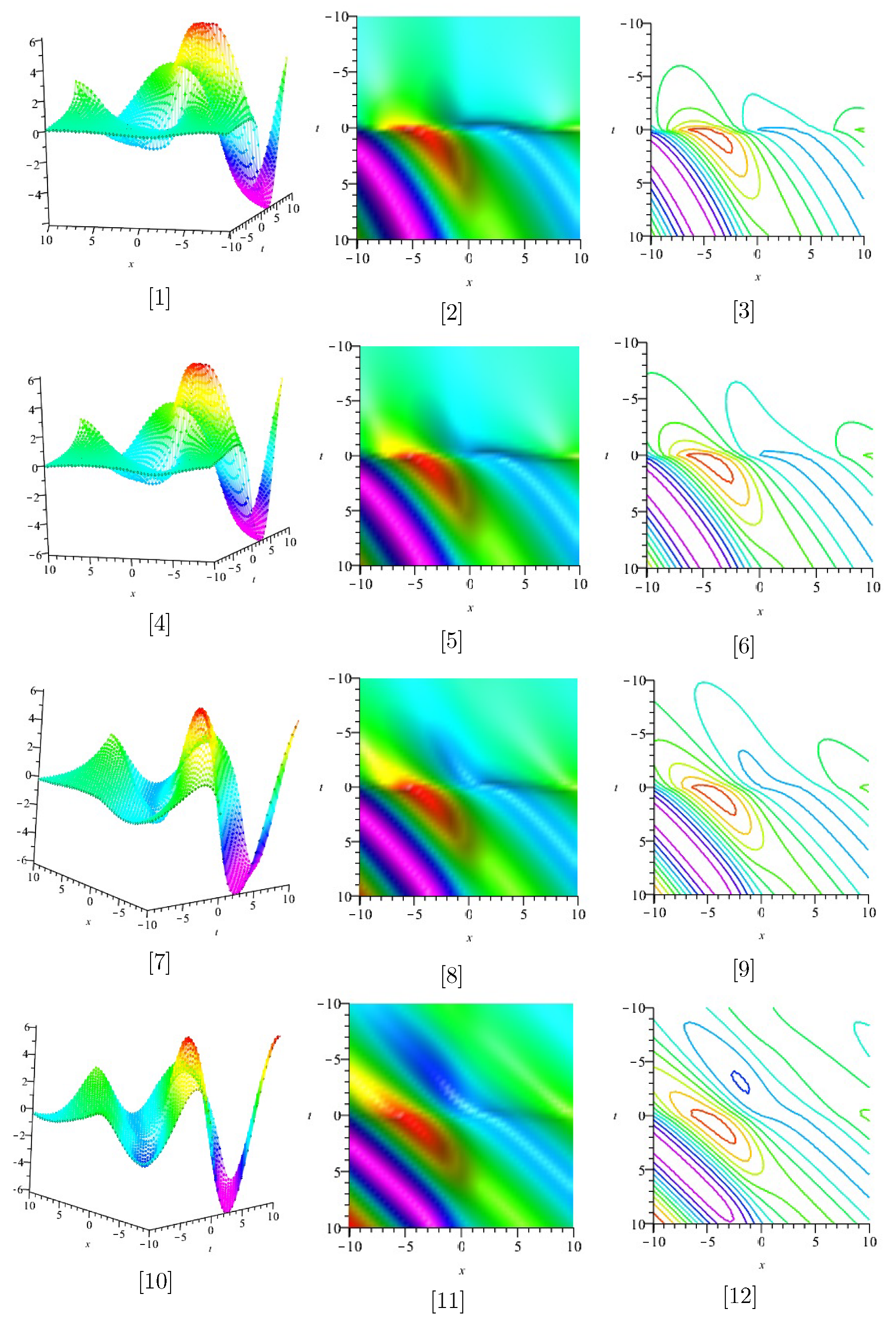Uncertain Asymptotic Stability Analysis of a Fractional-Order System with Numerical Aspects
Abstract
1. Introduction
- Lyapunov stability: if the solutions that start out near an equilibrium point stay near forever, then is Lyapunov stable.
- Asymptotic stability: if is Lyapunov stable and all solutions that start out near converge to then is said to be asymptotically stable.
- Exponential stability: this stability guarantees a minimal rate of decay, i.e., an estimate of how quickly the solutions converge.
- Probability stability: a property of probability distributions.
- Algebraic geometry stability: this stability is a notion which characterizes when a geometric object has some desirable properties for the purpose of classifying them.
- Numerical stability: a property of numerical algorithms which describes how errors in the input data propagate through the algorithm.
- K-stability: a stability condition for algebraic varieties.
- Radius stability: a property of continuous polynomial functions.
- Learning theory stability: a property of machine learning algorithms.
- (–Hilfer derivative).
- (–Riemann–Liouville integral).
- .
- (and
- (Conformable derivative),
- (Riemann–Liouville derivative).
- (Riemann–Liouville derivative).
- (Caputo derivative).
2. Preliminaries
2.1. Fox’s –Functions
- Exponential map
- Mittag-Leffler function with 1 parameter.
- Gauss Hypergeometric function
- Wright function
- –function
- Fox–Wright function
- Meijer -function
2.2. Generalized Triangular Norms (GTNs)
2.3. Fuzzy Normed Spaces
- is a linear space.
- is a family of matrix-valued fuzzy (shortly, MVF) sets .
- is a continuous increasing function.
- for all and .
- for each , and
2.4. MV Random Normed (MVRN) Spaces
- is a vector space.
- is a set of MV distribution functions (MVDFs)
- is a left-continuous and non-decreasing function.
- and
- contains functions s.t.,
- for every and
- the maximal element of is
- (1)
- iff
- (2)
- for every
- (3)
- .
2.5. Mittag-Leffler Function and Its Approximations
2.6. Fractional Derivatives
2.6.1. Hilfer Derivative
2.6.2. Conformable Derivative
2.6.3. Riemann–Liouville Derivative
2.6.4. Caputo Derivative
2.7. Fractional-Order Delayed Matrix Sine and Cosine
2.8. Aggregate Maps
- Geometric mean functions
- Arithmetric mean functions
- Maximum functions
- Minimum functions
- Median of odd numbers
- Median of even numbers
- Sum functions:
- Product functions:
2.9. Alternative Fixed Point Theory [22]
- (1)
- The fixed point of is the convergence point of ;
- (2)
- In the set , is the unique fixed point of ;
- (3)
- .
2.10. The First Kudryashov-Type Method
2.11. Gronwall Inequality
3. Fuzzy Stability Results of (1) for Case 1
3.1. Fuzzy Multistability Results for Finite Domains
3.2. Fuzzy Multi-Stability Results for Unbounded Domains
4. Results of (1) for Case 2
Application of the First Kudryashov-Type Method
5. Fuzzy Asymptotic Stability Results of (1) for Case 3
6. Fuzzy Asymptotic Stability Results of (1) for Case 4
7. Random Finite-Time Stability Results of (1) for Case 5
- (i)
- (ii)
8. Conclusions
Author Contributions
Funding
Data Availability Statement
Conflicts of Interest
References
- Milbradt, D.M.C.; de Oliveira Evald, P.J.D.; Hollweg, G.V.; Grindling, H.A. A Hybrid Robust Adaptive Sliding Mode Controller for partially modelled systems: Discrete-time Lyapunov stability analysis and application. Nonlinear Anal. Hybrid Syst. 2023, 48, 101333. [Google Scholar] [CrossRef]
- Wang, R.; Caraballo, T.; Tuan, N. Asymptotic stability of evolution systems of probability measures for nonautonomous stochastic systems: Theoretical results and applications. Proc. Am. Math. Soc. 2023, 151, 2449–2458. [Google Scholar] [CrossRef]
- Chaillet, A.; Karafyllis, I.; Pepe, P.; Wang, Y. Growth conditions for global exponential stability and exp-ISS of time-delay systems under point-wise dissipation. Syst. Control. Lett. 2023, 178, 105570. [Google Scholar] [CrossRef]
- Barbieri, S. Semi-algebraic Geometry and generic Hamiltonian stability. arXiv 2023, arXiv:2402.10707. [Google Scholar]
- Shibasaki, R.S.; Rossi, A.; Gurevsky, E. A new upper bound based on Dantzig-Wolfe decomposition to maximize the stability radius of a simple assembly line under uncertainty. Eur. J. Oper. Res. 2024, 313, 1015–1030. [Google Scholar] [CrossRef]
- Chen, Q.; Shui, C.; Han, L.; Marchand, M. On the Stability-Plasticity Dilemma in Continual Meta-Learning: Theory and Algorithm. Adv. Neural Inf. Process. Syst. 2024, 36, 1–55. [Google Scholar]
- Weilbeer, M. Efficient Numerical Methods for Fractional Differential Equations and Their Analytical. Ph.D. Dissertation, Technischen Universität Braunschweig, Braunschweig, Germany, 2005; pp. 1–224. [Google Scholar]
- LaSalle, J.; Lefschetz, S. Stability by Liapunov’s Direct Method with Applications; Academic Press: New York, NY, USA, 1961. [Google Scholar]
- Demidowicz, B.P. Mathematical Theory of Stability; WNT: Warsaw, Poland, 1972. [Google Scholar]
- Mitkowski, P.J. Mathematical Structures of Ergodicity and Chaos in Population Dynamics; Springer: Berlin/Heidelberg, Germany, 2021; Volume 312. [Google Scholar]
- Selvam, A.P.; Govindaraj, V. Investigation of controllability and stability of fractional dynamical systems with delay in control. Math. Comput. Simul. 2024, 220, 89–104. [Google Scholar] [CrossRef]
- O’Regan, D.; Aderyani, S.R.; Saadati, R.; Allahviranloo, T. Solving the Fornberg-Whitham Model Derived from Gilson-Pickering Equations by Analytical Methods. Axioms 2024, 13, 74. [Google Scholar] [CrossRef]
- Marian, D.; Ciplea, S.A.; Lungu, N. On Ulam-Hyers stability for a system of partial differential equations of first order. Symmetry 2020, 12, 1060. [Google Scholar] [CrossRef]
- Ulam, S.M. A Collection of Mathematical Problems; Interscience: New York, NY, USA, 1960. [Google Scholar]
- Hyers, D.H. On the stability of the linear functional equation. Proc. Natl. Acad. Sci. USA 1941, 27, 221–224. [Google Scholar] [CrossRef]
- Alsina, C.; Ger, R. On some inequalities and stability results related to exponential function. J. Inequal. Appl. 1998, 2, 373–380. [Google Scholar] [CrossRef]
- Jung, S.-M. Hyers-Ulam stability of linear differential equations of first order. Appl. Math. Lett. 2004, 17, 1135–1140. [Google Scholar] [CrossRef]
- Jung, S.-M.; Rassias, T.M. Ulam’s problem for approximate homomorphisms in connection with Bernoulli’s differential equation. Appl. Math. Comput. 2007, 187, 223–227. [Google Scholar] [CrossRef]
- Jung, S.-M.; Rassias, T.M. Generalized Hyers-Ulam stability of Riccati differential equation. Math. Inequal. Appl. 2008, 11, 777–782. [Google Scholar] [CrossRef]
- Prastaro, A.; Rassias, T.M. Ulam stability in geometry of PDE’s. Nonlinear Funct. Anal. Appl. 2003, 8, 259–278. [Google Scholar]
- Aderyani, S.R.; Saadati, R.; Abdeljawad, T.; Mlaiki, N. Multi-stability of non homogenous vector-valued fractional differential equations in matrix-valued Menger spaces. Alex. Eng. J. 2022, 61, 10913–10923. [Google Scholar] [CrossRef]
- Aderyani, S.R.; Saadati, R. Stability and controllability results by n–ary aggregation functions in matrix valued fuzzy n–normed spaces. Inf. Sci. 2023, 643, 119265. [Google Scholar] [CrossRef]
- Ababneh, O. Adaptive synchronization and anti-synchronization of fractional order chaotic optical systems with uncertain parameters. J. Math. Comput. Sci. 2021, 23, 302–314. [Google Scholar] [CrossRef]
- Li, C.; Nonlaopon, K.; Hrytsenko, A.; Beaudin, J. On the analytic and approximate solutions for the fractional nonlinear Schrodinger equations. J. Nonlinear Sci. Appl. 2023, 16, 51–59. [Google Scholar] [CrossRef]
- Agarwal, R.; Chandola, A.; Mishra Pandey, R.; Sooppy Nisar, K. Parameter Mittag–Leffler function, its various properties, and relation with fractional calculus operators. Math. Methods Appl. Sci. 2021, 44, 5365–5384. [Google Scholar] [CrossRef]
- Abubakar, U.M. Some results on generalized Euler-type integrals related to the four parameters Mittag-Leffler function. J. New Results Sci. 2021, 10, 1–10. [Google Scholar] [CrossRef]
- Ozarslan, M.A.; Fernandez, A. On a five-parameter Mittag-Leffler function and the corresponding bivariate fractional operators. Fractal Fract. 2021, 5, 45. [Google Scholar] [CrossRef]
- Olutimo, A.L.; Bilesanmi, A.; Omoko, I.D. Stability and boundedness analysis for a system of two nonlinear delay differential equations. J. Nonlinear Sci. Appl. 2023, 16, 90–98. [Google Scholar] [CrossRef]
- Mihet, D. On the stability of the additive Cauchy functional equation in random normed spaces. Appl. Math. Lett. 2011, 24, 2005–2009. [Google Scholar] [CrossRef][Green Version]
- Li, C.P.; Chen, G. Estimating the Lyapunov exponents of discrete systems. Chaos 2004, 14, 343–346. [Google Scholar] [CrossRef] [PubMed]
- Rezazadeh, H.; Davodi, A.G.; Gholami, D. Combined formal periodic wave-like and soliton-like solutions of the conformable Schrodinger-KdV equation using the G′/G-expansion technique. Results Phys. 2023, 47, 106352. [Google Scholar] [CrossRef]
- Shakeri, S.; Ciric, L.J.B. Common fixed point theorem in partially ordered L-fuzzy metric spaces. Fixed Point Theory Appl. 2010, 2010, 125082. [Google Scholar] [CrossRef][Green Version]
- Aderyani, S.R.; Saadati, R.; O’Regan, D.; Alshammari, F.S. Fuzzy Approximate Solutions of Matrix-Valued Fractional Differential Equations by Fuzzy Control Functions. Mathematics 2023, 11, 1386. [Google Scholar] [CrossRef]
- Yang, X.J. Theory and Applications of Special Functions for Scientists and Engineers; Springer: Singapore, 2021. [Google Scholar]
- Pan, R.; Fan, Z. Analyses of solutions of Riemann Liouville fractional oscillatory differential equations with pure delay. Math. Methods Appl. Sci. 2023, 46, 10450–10464. [Google Scholar] [CrossRef]
- Zhang, F.Z. Matrix Theory, Universitext; Springer: New York, NY, USA, 1999. [Google Scholar]
- Abdullah, T.Q.S.; Xiao, H.; Huang, G.; Al-Sadi, W. Stability and existence results for a system of fractional differential equations via Atangana-Baleanu derivative with p-Laplacian operator. J. Math. Comput. Sci. 2022, 27, 184–195. [Google Scholar] [CrossRef]
- Mahmudov, N.I. A novel fractional delayed matrix cosine and sine. Appl. Math. Lett. 2019, 92, 41–48. [Google Scholar] [CrossRef]
- Ryabov, P.N.; Sinelshchikov, D.I.; Kochanov, M.B. Application of the Kudryashov method for finding exact solutions of the high order nonlinear evolution equations. Appl. Math. Comput. 2011, 218, 3965–3972. [Google Scholar] [CrossRef]
- Corduneanu, C. Principles of Differential and Integral Equations; Allyn and Bacon: Boston, MA, USA, 1971. [Google Scholar]
- Youssef, M.I. Generalized fractional delay functional equations with Riemann-Stieltjes and infinite point nonlocal conditions. J. Math. Comput. Sci. 2022, 24, 33–48. [Google Scholar] [CrossRef]
- Long, L.D. Cauchy problem for inhomogeneous fractional nonclassical diffusion equation on the sphere. J. Math. Comput. Sci. 2022, 25, 303–311. [Google Scholar] [CrossRef]
- Asjad, M.I.; Ullah, N.; Rehman, H.U.; Baleanu, D. Optical solitons for conformable space-time fractional nonlinear model. J. Math. Comput. Sci. 2022, 27, 28–41. [Google Scholar] [CrossRef]
- Wusu, A.S.; Olabanjo, O.A.; Akanbi, M.A. A model for analysing the dynamics of the second wave of corona virus (COVID–19) in Nigeria. J. Math. Comput. Sci. 2022, 26, 16–21. [Google Scholar] [CrossRef]
- Demma, M.; Vetro, P. Fixed point results on b-metric space via Picard sequences and b-simulation functions. Iran. J. Math. Sci. Inform. 2016, 11, 123–136+156. [Google Scholar]
- Kahouli, O.; Makhlouf, A.B.; Mchiri, L.; Rguigui, H. Hyers–Ulam stability for a class of Hadamard fractional Itô–Doob stochastic integral equations. Chaos Solitons Fractals 2023, 166, 112918. [Google Scholar] [CrossRef]
- Kasinathan, R.; Kasinathan, R.; Sandrasekaran, V.; Baleanu, D. Existence and Hyers-Ulam stability of stochastic integrodifferential equations with a random impulse. J. Inequal. Appl. 2023, 2023, 116. [Google Scholar] [CrossRef]
- Long, P.; Murugusundaramoorthy, G.; Tang, H.; Wang, W. Subclasses of analytic and bi-univalent functions involving a generalized Mittag-Leffler function based on quasi-subordination. J. Math. Comput. Sci. 2022, 26, 379–394. [Google Scholar] [CrossRef]
- Zhao, K. Generalized UH-stability of a nonlinear fractional coupling (p 1, p 2)-Laplacian system concerned with nonsingular Atangana-Baleanu fractional calculus. J. Inequal. Appl. 2023, 2023, 96. [Google Scholar] [CrossRef]
- AlAhmad, R.; AlAhmad, Q.; Abdelhadi, A. Solution of fractional autonomous ordinary differential equations. J. Math. Comput. Sci. 2022, 27, 59–64. [Google Scholar] [CrossRef]
- Salgado, S.A.B.; Esmi, E.; de Souza, S.M.; Rojas, O.; de Barros, L.C. Fuzzy stationary Schrödinger equation with correlated fuzzy boundaries. Soft Comput. 2024, 28, 1943–1955. [Google Scholar] [CrossRef]
- Li, Z.; Liu, C. Chaotic pattern and traveling wave solution of the perturbed stochastic nonlinear Schrödinger equation with generalized anti-cubic law nonlinearity and spatio-temporal dispersion. Results Phys. 2024, 56, 107305. [Google Scholar] [CrossRef]
- Aderyani, S.R.; Saadati, R.; Vahidi, J.; Gomez-Aguilar, J.F. The exact solutions of conformable time-fractional modified nonlinear Schrodinger equation by first integral method and functional variable method. Opt. Quantum Electron. 2022, 54, 218. [Google Scholar] [CrossRef]
- O’Regan, D.; Aderyani, S.R.; Saadati, R.; Inc, M. Soliton Solution of the Nonlinear Time Fractional Equations: Comprehensive Methods to Solve Physical Models. Axioms 2024, 13, 92. [Google Scholar] [CrossRef]
- Zhang, F.; Li, C. Stability analysis of fractional differential systems with order lying in (1, 2). Adv. Differ. Equ. 2011, 2011, 213485. [Google Scholar] [CrossRef]
- Park, C.; O’Regan, D. Stability of some set-valued functional equations. Appl. Math. Lett. 2011, 24, 1910–1914. [Google Scholar] [CrossRef]
- Wang, J.; Sathiyaraj, T.; O’Regan, D. Relative controllability of a stochastic system using fractional delayed sine and cosine matrices. Nonlinear Anal. Model. Control 2021, 26, 1031–1051. [Google Scholar] [CrossRef]
- Liang, C.; Wang, J.; O’Regan, D. Representation of a solution for a fractional linear system with pure delay. Appl. Math. Lett. 2018, 77, 72–78. [Google Scholar] [CrossRef]
- Altaweel, N.H.; Rashid, M.H.; Albalawi, O.; Alshehri, M.G.; Eljaneid, N.H.; Albalawi, R. On the Ideal Convergent Sequences in Fuzzy Normed Space. Symmetry 2023, 15, 936. [Google Scholar] [CrossRef]




| (0, 0.025) | (0.025, 0.050) | (0.050, 0.075) | (0.075, 0.100) | |
|---|---|---|---|---|
| 0.0317 | 0.0620 | 0.0829 | 0.0857 | |
| 0.0286 | 0.0579 | 0.0764 | 0.0810 | |
| 0.0214 | 0.0548 | 0.0705 | 0.0789 | |
| 0.0198 | 0.0413 | 0.0507 | 0.0696 | |
| 0.0129 | 0.0364 | 0.0489 | 0.0601 | |
| 0.0107 | 0.0207 | 0.0360 | 0.0549 | |
| 0.0095 | 0.0199 | 0.0317 | 0.0501 | |
| 0.0048 | 0.0076 | 0.0221 | 0.0449 |
Disclaimer/Publisher’s Note: The statements, opinions and data contained in all publications are solely those of the individual author(s) and contributor(s) and not of MDPI and/or the editor(s). MDPI and/or the editor(s) disclaim responsibility for any injury to people or property resulting from any ideas, methods, instructions or products referred to in the content. |
© 2024 by the authors. Licensee MDPI, Basel, Switzerland. This article is an open access article distributed under the terms and conditions of the Creative Commons Attribution (CC BY) license (https://creativecommons.org/licenses/by/4.0/).
Share and Cite
Aderyani, S.R.; Saadati, R.; O’Regan, D.; Alshammari, F.S. Uncertain Asymptotic Stability Analysis of a Fractional-Order System with Numerical Aspects. Mathematics 2024, 12, 904. https://doi.org/10.3390/math12060904
Aderyani SR, Saadati R, O’Regan D, Alshammari FS. Uncertain Asymptotic Stability Analysis of a Fractional-Order System with Numerical Aspects. Mathematics. 2024; 12(6):904. https://doi.org/10.3390/math12060904
Chicago/Turabian StyleAderyani, Safoura Rezaei, Reza Saadati, Donal O’Regan, and Fehaid Salem Alshammari. 2024. "Uncertain Asymptotic Stability Analysis of a Fractional-Order System with Numerical Aspects" Mathematics 12, no. 6: 904. https://doi.org/10.3390/math12060904
APA StyleAderyani, S. R., Saadati, R., O’Regan, D., & Alshammari, F. S. (2024). Uncertain Asymptotic Stability Analysis of a Fractional-Order System with Numerical Aspects. Mathematics, 12(6), 904. https://doi.org/10.3390/math12060904









